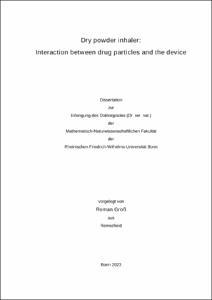Dry powder inhalerInteraction between drug particles and the device

Dry powder inhaler
Interaction between drug particles and the device

| dc.contributor.advisor | Lamprecht, Alf | |
| dc.contributor.author | Groß, Roman | |
| dc.date.accessioned | 2023-09-28T10:07:13Z | |
| dc.date.available | 2024-10-01T22:00:15Z | |
| dc.date.issued | 28.09.2023 | |
| dc.identifier.uri | https://hdl.handle.net/20.500.11811/11075 | |
| dc.description.abstract | Dry powder inhalers (DPIs) are delivery devices used to administer the required medication to the patient. Since formulation development has always played an important role, the first study compared the traditional formulation process, in which the drug is ground and then mixed with carrier particles to form interactive mixtures, with a modern and common approach, spray-drying. The drug rivaroxaban was selected and both formulation techniques were compared in terms of the aerodynamic behavior of the developed formulations. This antithrombotic drug was used as an example to show new possibilities for pulmonary application using the lung area as an absorption pathway. Different batches of the drug were prepared and tested in-vitro to analyze the amount of particles that could potentially enter the lungs. Also, a dry powder insufflator for the application of the formulations in rats was developed and 3D printed. The different formulations were tested in in-vivo experiments and plasma concentrations were determined after application over an extended period of time.
Second, the state of the art in capsule-based DPIs is highlighted and a novel DPI is presented and compared in-vitro with two commercially available devices. Since each DPI has a different deagglomeration concept in terms of device geometry and capsule motion, the advantages and disadvantages for aerosolization of different formulations developed with different formulation techniques can be highlighted. Since both high intrinsic and low intrinsic airflow devices were used in this study, it was possible to show which class of DPIs exhibited deagglomeration of the formulation regardless of the inspiratory conditions used, since two actuation flow rates were tested. The next chapter addresses the reduction of powder retention within the DPI, as this is a critical factor that results in a quantifiable amount of drug not being available for lung treatment. Therefore, the focus was put on the surface properties (chemistry, texture), as this is currently a more or less unknown and also underestimated screw to optimize the emitted fraction during inhalation. To this end, the inner surface of the novel and previously described DPI was modified with cold plasma to affect the interaction between the device surface and the formulation. In this study, the activated/hydrophilic and inert/hydrophobic surface properties produced by oxygen or octafluorocyaclobutane plasma represent the chemical modification of the surface. To analyze the influence of surface texture, rough or smooth surfaces were generated by plasma etching or coating with different monomers. Finally, the patient's influence on the inhalation maneuver, was focused on. Since currently there is a lack in providing feedback to the patient after the inhalation process a prototype of a novel feedback mechanism for capsule-based DPIs is presented. Since the movement of the capsule is decisive for powder deagglomeration in this class of device, and the speed of the respective capsule movement depends on the force and duration of the inhalation maneuver performed by the patient, this component was focused on to feedback inhalation. To evaluate the feedback mechanism, a Lupihaler device was chosen as a DPI in which the capsule undergoes a rotational movement during inhalation. | en |
| dc.language.iso | eng | |
| dc.rights | Namensnennung 4.0 International | |
| dc.rights.uri | http://creativecommons.org/licenses/by/4.0/ | |
| dc.subject | DPI | |
| dc.subject | Trockenpulverinhalator | |
| dc.subject | Sprühtrocknung | |
| dc.subject | Formulierungsentwicklung | |
| dc.subject | Kapselbewegung | |
| dc.subject.ddc | 500 Naturwissenschaften | |
| dc.title | Dry powder inhaler | |
| dc.title.alternative | Interaction between drug particles and the device | |
| dc.type | Dissertation oder Habilitation | |
| dc.publisher.name | Universitäts- und Landesbibliothek Bonn | |
| dc.publisher.location | Bonn | |
| dc.rights.accessRights | openAccess | |
| dc.identifier.urn | https://nbn-resolving.org/urn:nbn:de:hbz:5-72248 | |
| dc.relation.doi | https://doi.org/10.3390/pharmaceutics14061185 | |
| dc.relation.doi | https://doi.org/10.1208/s12249-022-02436-0 | |
| ulbbn.pubtype | Erstveröffentlichung | |
| ulbbnediss.affiliation.name | Rheinische Friedrich-Wilhelms-Universität Bonn | |
| ulbbnediss.affiliation.location | Bonn | |
| ulbbnediss.thesis.level | Dissertation | |
| ulbbnediss.dissID | 7224 | |
| ulbbnediss.date.accepted | 09.08.2023 | |
| ulbbnediss.institute | Mathematisch-Naturwissenschaftliche Fakultät : Fachgruppe Pharmazie / Pharmazeutisches Institut | |
| ulbbnediss.fakultaet | Mathematisch-Naturwissenschaftliche Fakultät | |
| dc.contributor.coReferee | Wagner, Karl | |
| ulbbnediss.date.embargoEndDate | 01.10.2024 |
Files in this item
This item appears in the following Collection(s)
-
E-Dissertationen (4370)




